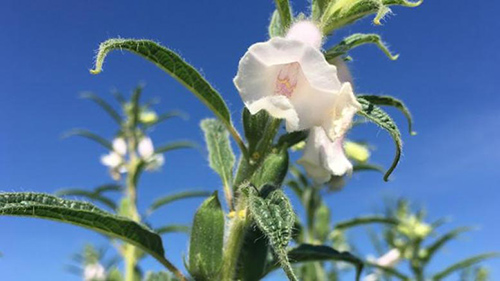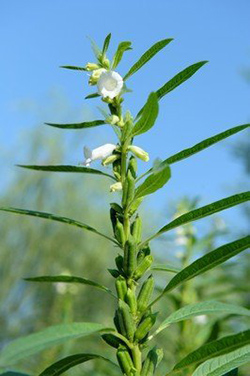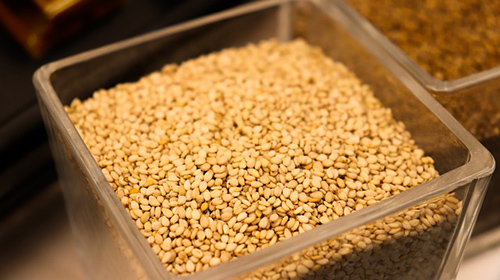Contents
The oily sesame plant has been cultivated since ancient times. In Egypt, India, China, Greece, and Babylon, its seeds were highly appreciated as a seasoning and exquisite and nourishing food. In the tomb of Ramses the Third (thirteenth century B.C.), a wall picture shows ancient Egyptians adding sesame seeds to bread. At present, it is still prevalent in Oriental and American countries, where it is even used to prepare a soft drink which women take to promote milk secretion in breastfeeding periods.

Sesame Plant Scientific Facts
- Scientific name: Sesamum Indicum L.
- French: Sesame.
- Spanish: Sesamo, ajonjoli.
- Environment: The sesame plant is native to Middle Eastern countries and India. Its cultivation has spread to other tropical and subtropical regions of the Americas, Africa, and the Mediterranean.
- Description: The sesame plant is a Herbaceous plant of the Pedaliaceae family, growing up to 1.5 m high. It has purple, pink, or white flowers. The fruits are cotton capsules that contain several seeds from 2 to 5 mm long, brown in color, and flat. Other sesame varieties present also red or black seeds.
- Parts of the plant used medicinally: The seeds.
Healing Properties and Indications
Sesame seeds contain many nutritional components with a high biological value.

- Lipids or fats (52%), practically all of them unsaturated fatty acids, make the plant effective in decreasing the level of cholesterol in the blood. Among the fats, sesame contains lecithin, a phospholipid (phosphate fat) essential in organic processes. It is an integral component of nervous tissues, and it is also found in the blood, semen, and bile, and it plays a role in the functioning of sexual glands.
Lecithin is a powerful emulsion agent that promotes the dissolution of fats in water environments. One of its roles in blood flow is to keep fats, especially cholesterol, dissolved, thus avoiding the formation of fat layers on the walls of arteries (arteriosclerosis). Sesame and soya are the plants with the highest amount of lecithin. - Proteins (20%) of high biological value, formed by 15 different amino acids, with a high proportion of methionine (an essential amino acid).
- Vitamins, especially vitamin E (tocopherol), B1 or thiamine (0.1 mg per 100 g), and B2 or riboflavin (0.24 mg per 100 g).
- Minerals and trace elements, especially calcium, phosphorus, iron, magnesium, and copper.
- Mucilage, to which sesame owes its mild laxative properties.

Bearing in mind the composition of this tiny seed, it is not strange that in Oriental countries, it can be regarded as a product that restores sexual vitality and capabilities. Among its many applications, we mention the following ones:
- Nervous problems. Mental or nervous exhaustion, stress, memory loss, melancholy, anxious depression, nervous imbalance or irritability, insomnia. Sesame is an excellent nutritional supplement for people undergoing high mental or intellectual activity and wanting to maintain good performance levels.
- Physical overload. Sports training, pregnancy, breastfeeding, and recovery from surgery or diseases.
- Lack of performance or sexual capabilities, both in men and women.
- Decrease of cholesterol in blood, arteriosclerosis, prevention of heart attacks, and arterial thrombosis.
Traditional Methods to Prepare Sesame

There are three methods to prepare sesame apart from toasting seeds. These methods allow you to take advantage of the plant’s medicinal properties.
- Sesame oil. It can be used like any other plant oil and seldom becomes rancid.
- Tahini. A tasteful paste is obtained by milling sesame oils, which is even better than butter.
- Sesame salt. A paste formed 14 parts of ground toasted sesame and one of sea salt. Besides its medicinal properties, it is an excellent, popular seasoning in Oriental countries.
How to use Sesame
- Sesame seeds can be eaten raw or slightly toasted. First, they should be put into water, steeped for 15 minutes, then strained. This way, the seeds are cleaned from small pebbles and may be mixed with the earth. After cleaning, toast them in a pan, moving them continuously with a wooden spoon to avoid burning. Please keep them in a glass jar or bottle. Take two or three teaspoonfuls after breakfast and lunch.
DISCLAIMER: All content on this website is presented solely for educational and informational objectives. Do not rely on the information provided as a replacement for advice, diagnosis, or treatment from a qualified medical expert. If you are pregnant, nursing, or have any preexisting medical concerns, talk to your doctor before using any herbal or natural medicines.
REFERENCES
- George D. Pamplona-Roger, M.D. “Encyclopedia of Medicinal Plants.” George D. Pamplona-Roger, M.D. Encyclopedia of Medicinal Plants. Ed. Francesc X. Gelabert. vols. 2 San Fernando de Henares: Editorial Safeliz, 2000. 611, 612. Print. [sesame plant]
- NCBI: https://www.ncbi.nlm.nih.gov/pmc/articles/PMC9573514/
- Health Benefits of Sesame Seeds: https://sesamecare.com/blog/sesame-seeds-health-benefits
